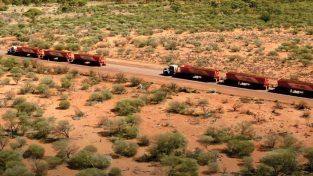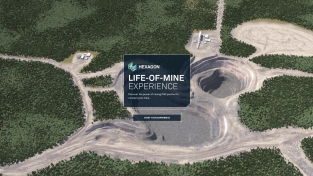Have we arrived at the age of attainable autonomy? Where are we within the maturity curve of delivering an autonomous future? Andrew Crose, VP-Autonomous, Hexagon’s Mining division, will unpack the drivers of the fast-coming age of attainable autonomy from the perspective of technology, value creation and society.
BK: Welcome to HxGN Radio. My name is Brian, and in today’s podcast, we’re discussing mining and autonomy.
There’s more to mining’s autonomous future than just technology. Value creation, change management and society in general are what keep Hexagon’s Andrew Crose busy when considering the right technology to drive the fast-coming age of attainable autonomy.
Andrew, thanks for joining me. Appreciate it.
AC: Yeah. Thank you. Appreciate being here.
BK: Yeah. I’m glad you’re here. And like we’ve been saying, we’re in person and it’s nice to see the face-to-face sort of thing, and so I appreciate you coming in and taking the time to do this.
So, tell us about yourself, what you do and what you’re nerding out on.
AC: Yeah, sure. So, a lot of what we work on or what I’ve been working on the last few years is around enabling operational intent and autonomy, so actually bringing autonomy from proof of concept to reality. And I guess in terms of nerding out, the thing that I really enjoy about this is this has helped me really travel the world and see some of the very unique places.
BK: Oh, nice.
AC: So just a quick look, I’ve been to about 41 countries in the last 10 years—
BK: Wow.
AC: —which just is amazing because autonomy is taking off everywhere.
BK: Yeah.
AC: From Australia or Chile, where it originated, throughout Canada, even Central Africa.
BK: Mm-hmm. Oh, that’s incredible.
So, I’m assuming you’re enjoying that, well, basically just seeing the world and experiencing new cultures. Do you enjoy doing that? Do you like travelling? I guess some people don’t really like it, but…
AC: I probably am on the different spectrum of I like travelling to places that people don’t go to.
BK: Yeah?
AC: So yeah, not necessarily the five-star hotels as much, but maybe the man camps in Central Africa—
BK: Yeah.
AC: —or the remote places where autonomy has initially taken off.
BK: That’s cool. Some of the best trips to different countries I’ve had is when I’ve just been able to say, “Hey, let’s hang out with some of the locals and just do whatever they do.” I don’t care about the tourist destinations. I just want to go and live life with them. and we did that a couple times, and that was the best experience, so…
AC: Absolutely. So, I was with some friends recently that have a mine in Gabon—
BK: Yeah.
AC: —and there are only locals there. So, it is quite a pleasure. In fact, walking around Las Vegas with him was interesting because we had a conversation where, yeah, we have just as much fun in Moanda, Gabon as we do in Las Vegas.
BK: I love it. That’s great. So, how did you come to Hexagon originally?
AC: Yeah, so I was working for a university, University of College Dublin, in Ireland, and was looking at different things of taking technology to market. And then some people that I’d worked with in the industry, some friends, asked me to come to Hexagon, said there was something unique and special going on here. And I’m glad they brought me in.
BK: Yeah. That’s great. And you’ve been with the company for…?
AC: Five years.
BK: Five years. Okay, good. I was just saying, I love the longevity. I keep hearing from various people coming in and talking, and it’s just like, hey, clearly people love working for Hexagon—
AC: Yeah, it’s a great company.
BK: —and being a part of it. That’s awesome.
All right. Well, let’s talk about mines. So, we know that every mine is unique obviously. But what are some of the common questions that companies should be asking before they embark on an autonomous programme, even with their uniquenesses?
AC: Yeah. So, I mean, a lot of autonomy today is that sort of second generation, moving past the proof of concepts or the initial legacy systems, and really making sure that you have a system that’s going to deliver results. Do you have a business objective for your autonomous programme? Is it aligned to production and revenue? Have you engaged all of the stakeholders in the process? because it’s not a proof of concept in an isolated area, but it’s something that’s going to impact the entire operation. Effectively, do you have operational intent for your autonomy?
BK: Yeah. Okay, excellent. So, now is there a typical roadmap that they should be following of some kind?
AC: Yeah, absolutely. So, it really starts with an autonomous feasibility study, and that’s going in and reviewing your plans and reviewing your mine method and your mining programme and your operations and determines if feasible to go to autonomous. And this comes into different factors, say the life of mine or the life of your equipment.
And then the next step is typically they look at a technological readiness. So, what’s the footprint of technology that we can use? Perhaps they have an existing manned fleet management system or a manned collision avoidance system that we could build on top of, and that makes the journey easier. Or perhaps we need to do a multi-year plan to build up that technological base to get them.
Then, you look at the operational readiness. Have they gone through all of the different change management training? The societal readiness, which is huge. I mean, we’re changing the world with autonomy.
BK: Yeah.
AC: And we have to take the world along with us on that journey. And then finally, doing the business case and really making sure this makes business sense.
BK: Good. Excellent.
What about some of the key principles to follow then, in addition to the roadmap? And if a company’s, obviously they want to achieve lasting value from their autonomous programme, what are some of those key principles that they should implement and follow?
AC: Like any investment, you really want to match the operational programme to the business case and the ROI. So, making sure that you have the technology plan to see through the ROI, that you’re going to go the five years, that you have the commitment to it. That you’ve built the staff, you’ve trained it. You’ve put it into an operational state to be sustained through the operation.
So, a big one in that regard is really just making sure that it has an operational handover milestone that’s set in place. I mean, a lot of them get stuck in a project phase—
BK: Sure.
AC: —because they haven’t thought through the ROI stuff of, well, how is this going to go live?
BK: Mm-hmm.
AC: But going live is the goal.
BK: Yeah. Okay.
So, now I’m just kind of curious on the side. If we don’t implement some of these principles and this roadmap, what’s happening? What’s going to happen?
AC: Absolutely. So, there’s all sorts of things that can happen, negative consequences, so especially in some of the places that mining operates are very remote. And in some places, like say for example, South Africa, there’s very high unemployment. And so if you do not take the local stakeholders on the autonomous journey with you, you risk the backlash of strikes or community unrest. And that’s never a good thing. Autonomy is there to help humanity.
BK: Exactly.
AC: Other things in terms of operational handoff. So, if you’re in the operations department, not the project department, and you don’t have an operational plan to hand it over, well then it’s viewed as just one more task that you’re giving the operations management.
BK: Yeah.
AC: And nobody likes more work.
BK: Yeah.
AC: So, you have to go in with that intent and that plan and saying, well, this is what happens once we go live.
BK: Mm-hmm. Okay. No, that makes sense. And you’re right about the… Well, and autonomy too is supposed to assist, not take the place… Well, I mean, I guess it takes the place of certain things, but then it allows you to be more efficient with other things.
AC: Absolutely. The repetitive tasks.
BK: Yes, yes.
AC: For example, long haulage is a repetitive task. You could have an 8-to-12-hour shift—
BK: Yeah.
AC: —driving the same haul roads, 24/7, middle of the night.
BK: Yep.
AC: It’s not necessarily safe. That’s why we sell collision avoidance and fatigue monitoring solutions. And by taking that task and automating it, we’re making it safer. We’re taking people out of a, what can be an unsafe task, but we’re creating other jobs, engineering jobs, supporting the system.
BK: So, for people that are not that familiar with the mining industry, talk about the dangers of some of the trucks basically. Talk about the size, the dangers, catastrophic situations and that kind of thing, which is why you’ve implemented these autonomous situations and safety procedures and everything like that.
AC: Absolutely. So, if you look at some of the solutions Hexagon sells to the mining industry, for example, the IDS slope monitoring radars is a great example. Slope failure. So, the steeper you can make a mine wall, the less it costs, because you have to move less waste to get to the ore. But the challenge is the steeper it is, the more likely it is to fail. So, we have a great technology in IDS that monitors the slopes from many kilometres away.
Now, if you have a situation say that could be a present danger, you can look at tele-remote shovels or autonomy and dozers. You can look at autonomous haul trucks and suddenly you’ve removed people from a slope that could potentially fail—
BK: Sure.
AC: —while still mining.
BK: Yeah, yeah.
All right. So, Hexagon has some recent partnerships with Volvo, MRL, and Liebherr. These obviously help to advance the industry towards an autonomous future. So, talk about that a little bit and talk about where that’s going.
AC: Yeah, absolutely. So, I mean, you’ve got two types of different partnerships there. So, Volvo and Liebherr are original equipment manufacturers of the trucks and shovels and other solutions. And it’s nice partnering with these industry stars because they allow us to start to build a standard in autonomy. It’s all about having an interoperable system. So, working with them allows us to build the protocols and start to get the critical mass of these protocols out there so that we can have interoperable autonomy, and that’s massive for the market.
And then MRL, I love the way they say they move mountains. And so, it’s great working with a partner that has operational intent baked into their tagline, into their slogan.
BK: Yeah.
AC: When they say they move mountains to put a mine in, well, then that sets the tone for how we do the project.
BK: Yeah. Nice.
Well, let’s talk about local communities. How can they be empowered in an autonomous project?
AC: Absolutely. So, a great example of that is a project we did in South Africa on a semi-autonomous mine, where the local community was feeling less than enfranchised in the process. And South Africa has historically high unemployment.
BK: Yeah.
AC: And we worked with the mine and the community, and we actually set up a business to do the ground zero, the boots on the ground support of our semi-autonomous system. So not that we have high failure rate, but if a rock falls on a cable and it needs to be… And it breaks, or something happens to the system where it needs to be fixed in the mine on the ground.
BK: Mm-hmm.
AC: So, we partnered, we helped establish a business with the local community and employed people. We gave them training. And they do that ground zero work for the mine—
BK: That’s awesome.
AC: —that we couldn’t necessarily do because of the location.
BK: Yeah.
AC: And the mine wasn’t really looking to do because it was extra tasks to put onto their staff.
BK: Mm-hmm. Oh, that’s great. I love that though. You’re working with the local community, you’re giving jobs, you’re giving opportunities, and you’re also utilising their talent that, like you said, you don’t really have or don’t really want to find at that point, just because of the capacity. You’re already at capacity with that. So that’s wonderful.
AC: Well, it’s a triple win.
BK: Yeah.
AC: It’s a win for us because establishing a local support that close to that remote area is hard. It’s a win for the community because we’re establishing a new business there. And it’s a win for the mine because they’re able to have a better supported system with that new company.
BK: Are you seeing these communities flourish through these opportunities that you’re giving them?
AC: Absolutely. It really brings a new skill set and a higher skill set to a community.
BK: Nice.
AC: So, these are, now they’re fully trained and skilled on as an autonomous hardware technician.
BK: Opportunities they wouldn’t have had otherwise.
AC: Oh, absolutely. Absolutely.
BK: Yeah. That’s awesome. That’s really, really neat.
All right. So, what’s coming in the future? What can we expect more from Hexagon and also the role in autonomous mining projects?
AC: Absolutely. So, I mean, what we’re really looking for is scale.
BK: Okay.
AC: Is the ability to scale up and move fast. So, if we were to say, look at our break by wire, speed by wire solution, we went from one mine that won a Hexagon Innovation Award at a live several years ago, six years ago. And that one mine helped us partner and build the technology in the proof case. But in the last 24 months, we went from one mine with a handful of trucks to 10 mines on four continents and 500 haul trucks. So, to scale the business and scale autonomy is the challenge if you want to automate the world.
BK: Yeah. That’s great. Well, where can we go to learn more about what you’re doing? And also, if you have any final thoughts too, please share.
AC: Yeah, absolutely. I mean, first, always just reach out to me.
BK: Okay.
AC: You can contact me on LinkedIn, happy to have a chat—
BK: Awesome.
AC: —because I love autonomy, love Hexagon, love our tech stack, and love talking about it.
The next thing obviously, the Hexagon mining website and the Hexagon website. We’ve got a lot of great content. We’ve got a lot of great information, whether it’s small information articles all the way through even sitting down with our experts and working with our advisors to take your mine autonomous.
BK: Glorious.
Well, Andrew, thank you so much. Really appreciate it. Thank you for sharing all this and taking the time today.
AC: Cool. Thank you.
BK: Andrew Crose, VP Autonomous, Hexagon’s Mining division, thank you so much for joining us here today on HxGN Radio.
For more information and to listen to additional episodes, head over to iTunes, Spotify, or SoundCloud. And you can visit hxgnspotlight.com for more storeys and more information from Hexagon.
Thank you again for listening and have a great day.
















